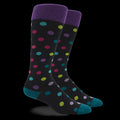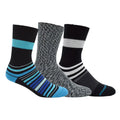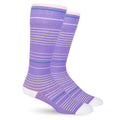Diabetes and Foot Health: The Importance of Non-Binding Diabetic Socks
Posted by HAYLIE SEGAL
Diabetes is a chronic condition that affects millions of people worldwide. One of the lesser-known complications of diabetes is its impact on foot health. Elevated blood sugar levels can lead to nerve damage (neuropathy) and poor circulation in the feet, increasing the risk of foot problems. In this blog, we will explore why diabetes affects the feet and the crucial role non-binding diabetic socks play in maintaining foot health for individuals living with diabetes.
Understanding the Impact of Diabetes on Feet
Diabetes can wreak havoc on various parts of the body, and the feet are no exception. The following are some of the reasons why diabetes affects foot health:
-
Neuropathy: High blood sugar levels can damage the nerves, leading to a condition known as diabetic neuropathy. Neuropathy can cause numbness, tingling, or loss of sensation in the feet. When foot sensation is diminished, minor injuries such as blisters or cuts may go unnoticed, making them susceptible to infections and complications.
-
Peripheral Arterial Disease (PAD): Diabetes can also lead to peripheral arterial disease, where blood vessels narrow and restrict blood flow to the extremities, including the feet. Reduced blood flow can slow down the healing process and increase the risk of infections.
-
Foot Deformities: Diabetes can alter the structure of the feet, causing deformities like bunions, hammertoes, and Charcot foot (a condition where the bones weaken and fracture). These deformities can create pressure points and increase the likelihood of developing sores and ulcers.
-
Infections and Ulcers: The combination of neuropathy and poor circulation makes the feet vulnerable to infections and non-healing ulcers. In severe cases, these ulcers can lead to gangrene, necessitating amputation.
The Role of Non-Binding Diabetic Socks
Given the potential complications associated with diabetes and foot health, individuals living with diabetes must take proactive measures to protect their feet. One essential item that can make a significant difference is non-binding diabetic socks. Here's why they are crucial:
-
Pressure Redistribution: Non-binding diabetic socks are designed with a looser, non-constricting cuff to prevent unnecessary pressure on the legs and feet. By redistributing pressure, they minimize the risk of constricting blood flow and aggravating circulation issues.
-
Moisture Management: Diabetic socks often utilize moisture-wicking materials that keep the feet dry and prevent the accumulation of sweat. Excess moisture can lead to fungal infections, which are particularly problematic for individuals with diabetes.
-
Seamless Design: Non-binding diabetic socks are crafted with a seamless interior to reduce friction against the skin. This feature is essential for individuals with neuropathy, as it decreases the likelihood of developing blisters and abrasions due to the lack of sensation.
-
Temperature Regulation: Keeping the feet at a comfortable temperature is essential for individuals with diabetes. Diabetic socks are designed to provide insulation without causing overheating, ensuring optimal foot health.
-
Antimicrobial Properties: Some non-binding diabetic socks are treated with antimicrobial agents that help control bacteria and fungus, further reducing the risk of infections.
-
Promotes Circulation: By preventing constriction and reducing pressure points, non-binding diabetic socks can help improve blood flow to the feet, supporting the overall health of the lower extremities.
Conclusion
Diabetes can have a profound impact on foot health, making it essential for individuals with diabetes to prioritize foot care. Non-binding diabetic socks play a crucial role in maintaining foot health by reducing pressure, managing moisture, and promoting optimal circulation. When combined with regular foot inspections, proper footwear, and professional medical care, non-binding diabetic socks can significantly reduce the risk of foot complications and enhance the quality of life for individuals living with diabetes.
If you or someone you know has diabetes, remember that taking care of your feet is not an option but a necessity. Investing in high-quality, non-binding diabetic socks like Dr. Segal's can make a world of difference, safeguarding your feet and helping you enjoy a healthier, more active life despite diabetes.
TAGS:
SHARE:




































